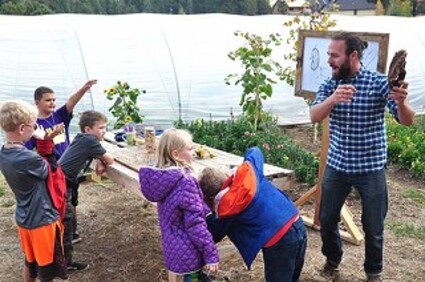Seed to Table's farm-based education blooms
Last updated 6/19/2018 at Noon
"What does a noodle tree look like?"
As they meandered through towering sugar snap peas and knee-high carrot tops at the Seed to Table education farm, one third-grader asked me this question, in all seriousness, about noodle trees. Tilting my head and smiling, I replied, "What a great question. I am so glad you are here!" Quickly, I change courses with my group, marching them out of the greenhouse to a patch of wheatgrass. I exclaim, "This is what a noodle tree looks like!"
Teaching farm-based education at the Seed to Table education farm for the past five years, I am often asked noodle-tree type questions. We can all remember a moment in life when we made the connections between a processed food item and its origin. The "aha" moment of mayonnaise starting as eggs, pickles as cucumbers, and noodles from wheat grass!
With so many different flavors, textures and smells from all around the globe in today's world, confusion about where food comes from seems only natural. And, after all, knowing where noodles come from is not necessary for meeting state education standards. But providing opportunities to make deep connections through real-life learning, with hands-on experiences, has helped make our Sisters School District the number-one district east of the Cascades.
On the farm, questions about pasta turn into a beautiful history lessons ending with an introduction to genetics. At the same time, students are introduced to eating and wellness habits that can successfully propel them through the rest of their lives; whatever they choose to do. Our living laboratory creates a vibrant landscape intertwining food, wellness and education.
In fact, Seed to Table's curriculum, administered through 12 farm field trips for every student between grades two and six, covers up to 50 of the state Department of Education's Next Generation Science Standards. This spring 700 students visited the farm learning about topics as diverse as nutrient cycling, decomposition, nutrition, environmental conservation and history.
One of Seed to Table's exciting new education components is the development of the Sisters High School's four-season greenhouse. The greenhouse is home to three different hydroponic systems as well as three 40-foot-long raised beds. Seed to Table manages the greenhouse and teaches the agriculture class alongside teacher Glenn Herron. This spring students eagerly filled the space, constructing new raised beds now overflowing with squash, tomatoes, eggplants, peppers, cucumbers and fig trees!
More than a few Sisters High School graduates, who have gone through Seed to Table's high school program, will be using what they've learned to go into health services, sustainable agriculture or environmental conservation. We, at Seed to Table, are simply thrilled that, going into our fifth summer season, our programs are impacting our students in such profoundly positive ways.

















Reader Comments(0)